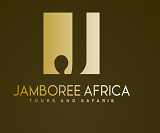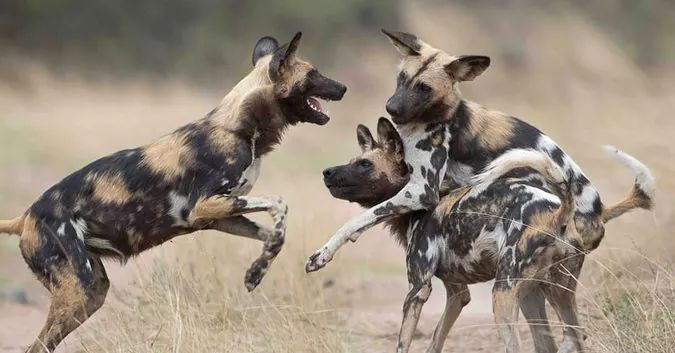
The African wild dog is the ‘most social out of the carnivores’, that line is often confused with the lion. The lion is the ‘most social out of the big cats’ — not carnivores.
Spotted hyenas are also social and can live in large clans, but this hyena and the lion are not as social as the African wild dogs, because when they hunt, the spotted hyenas and the lions split up (sometimes) and hunt in separate sub-groups for a while — like you may see only 1 or 2 lionesses, or spotted hyena, hunting and think they are part of a small pride or clan, but are in fact, usually part of a bigger pride or clan.
The African wild dog always hunt as one large pack and remain together — they are extremely fond of being together as a large family and if one is somehow separated, this is a highly stressful situation on both the pack, but more so for the separated wild dog.
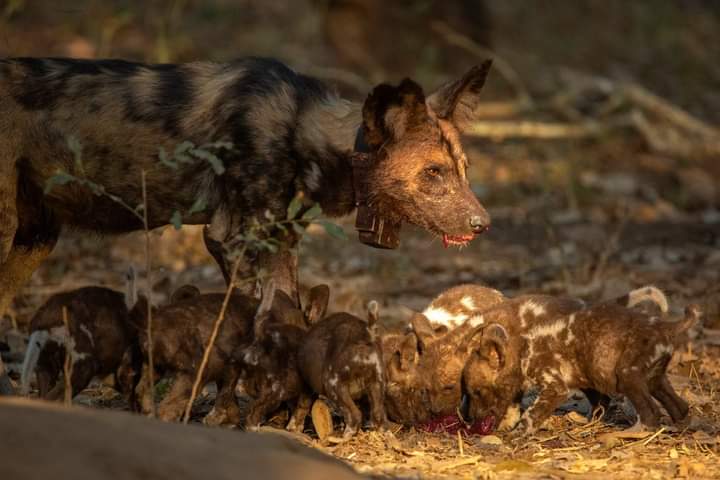
The endangered African wild dogs have enormous territories and move around a lot, until the alpha female (the only one to breed in the pack) finds a den to give birth to the pack’s new litter of pups.
The older pups stay with the pack for a few days and hunt with them and also help look after the new pups. Whenever the pack goes hunting, the pups are always guarded by a ‘babysitter’ — usually an older brother.
When the pack returns from the hunt, the entire pack contributes to feeding the pups and also regurgitate (not vomit, as the meat does not reach their stomach) the meat to feed the pups and the babysitter.
- Returning from a hunt, a radio collared dog (to collect important information), regurgitating meat to feed the hungry pups.
African wild dogs can live in large packs — up to 50, but that is an extreme and more often found in packs of 10-12. These are not large carnivores and about the size of your average sheepdog.
Although they don’t look as big and dangerous as some other carnivores, do not think you can tame or breed one with your dog. African wild dogs cannot be domesticated and cannot breed with any animal from the dog or wolf family. This dog can only breed with other African wild dogs — they only once belonged to the dog-like family (canid), but about 6 million years ago separated and now only found in their own family.
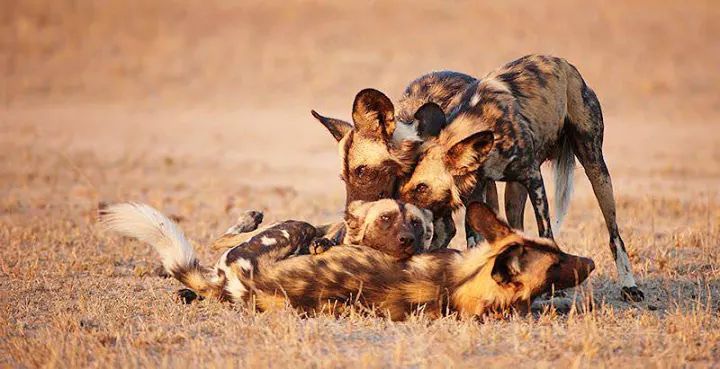
Besides us taking note of the African wild dog’s patches, its pack mates also take notice, and as no African wild dog has the same markings (like our fingerprints — every persons is different) — At a distance, it helps because they are able to tell one dog apart from the other.
When the African wild pups reach 8-10 weeks, they accompany the adults on hunts. These dogs are very family orientated and will even feed sick or injured pack mates. Some African wild dogs are also different, in that they allow the young, hunting pups to eat first from the kill.
African Wild Dog General fact
Across the world there are 34 wild dog families found — except on Antarctica. The dingo, found in Australia, is not strictly an indigenous breed, as it was introduced by man — a domestic dog that went wild. Out of those, two of them are one of the most endangered carnivores around — the Ethiopian wolf and the African wild dog/ Painted wolf.
Sometimes an African wild dog chases, say an impala, on its own. The impala is faster, but the African wild dog has more stamina, and tires the impala and quickly kills it, but then turns around to get the others and the pack returns to feed on the dead impala.
The one reason why too many believe they are gruesome predators is the method of the African wild dog’s way of killing — as mentioned, they mainly hunt during the day, so their hunts are noticed, but if you watch other hunters at night, dusk or dawn, you will notice some hunt the same way — disemboweling their prey.
To many, this seems ‘less honourable’, than, say a lion. A lion suffocates its prey… But, that takes far longer than the dogs. And added to that, while the poor prey is being suffocated it is being eaten alive by other pride members.
The African wild dogs are highly effective killers and kill within seconds, sometimes minutes. Ending the torture very quickly. They are, without a doubt, excellent at their job!
For its size, the wild dog eats more meat than any other predator. For example, in one area the African wild dog eats an average of 3.5 kg (7.7 pounds) of meat a day, and compare that to the spotted hyena that is about 3 times its size eats 3.8 kg (8.3 pounds). This is because of the African wild dog’s high energy requirements.
- They are enemies, so this is an unusual meeting.
The African wild dog is extremely social and they are very family orientated. This bond and caring flows with great strength among pack members, and this is so clear in the way they treat their pups. When it is time to feed off a kill, the pups eat first and the adults stand back and watch out for competitors.
You can say, their life revolves around pups and they are important to a pack, and this is why they do not breed often, or permanent breeders in arid regions, because the food is scarce and there is not enough to be a steady supply to feed the pups — so prey is not as easy to find as that in wetter areas.
- In a pack, only the alpha pair can breed, so thos adult ‘helpers’ are usually older brothers or sisters.
The survival of the African wild dog depends greatly on the amount of meat it can eat daily. It cannot go days without meat like any other predators. The African wild dog is too energetic and burns energy, fast, so it needs meat. This is one of the factors why African wild dogs are not seen in some areas — there is too little prey available.
African wild dogs are victims of a huge amount of land loss, and this terrible land loss ensures fewer prey — this puts them at odds with lions and spotted hyenas, and they kill the smaller and more vulnerable predators — who are actually more important in balancing the ecosystem. Of course they do not know this, they are only following natural instinct and killing the competitors for prey and we have made it so much easier for them, because we have forced these predators into smaller areas — unbalancing an ecosystem and ultimately destroying it.
- An African wild dog is no match for a lion. They naturally avoid each other, but now they cannot and this is one of the ‘knock on’ effects of habitat loss.
Dhole
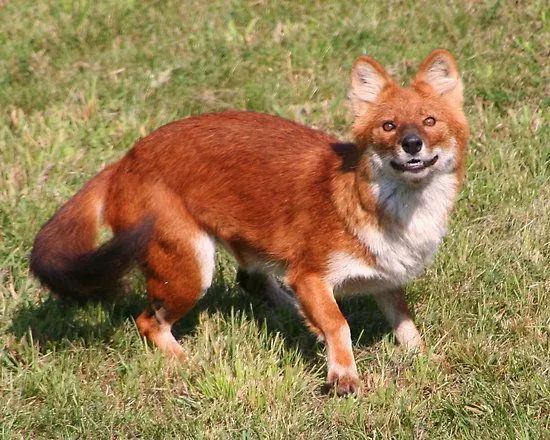
Sadly, this beautiful wild dog is threatened with extinction and there are less than 2, 500 of them left in the wild — it is also called the Asian wild dog, Asiatic wild dog, Indian wild dog, whistling dog, red dog, and mountain wolf. The dhole is native to Central, East and South, and Southeast Asia.
Their beautiful coat is redder in the winter and this is also why they are often described as a cross between a grey wolf and a red fox.
- Listed as endangered.
